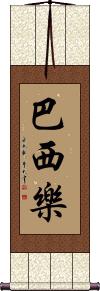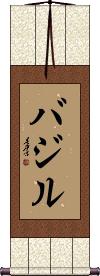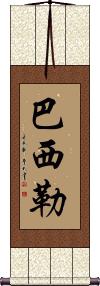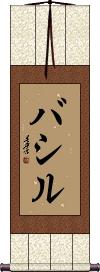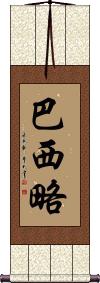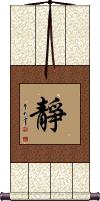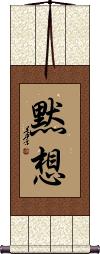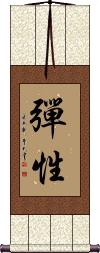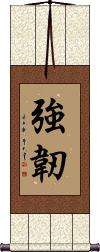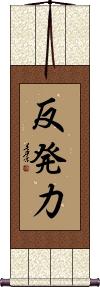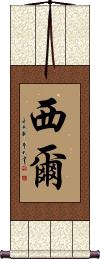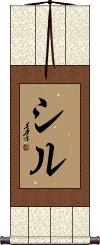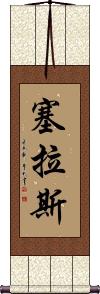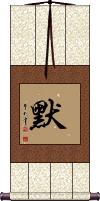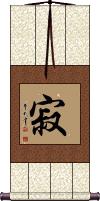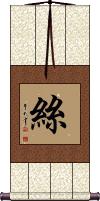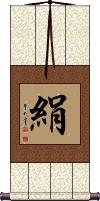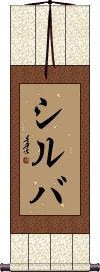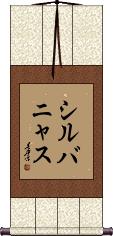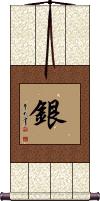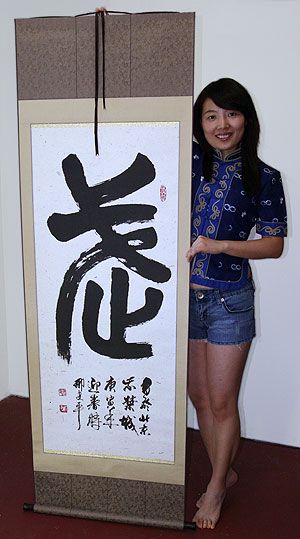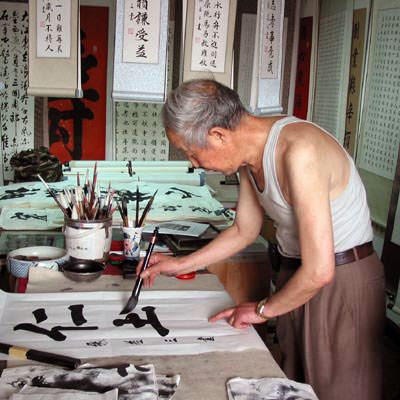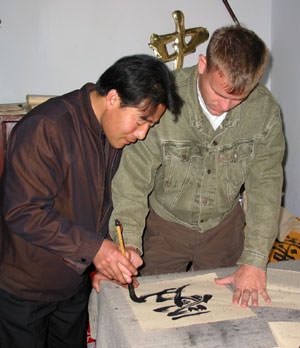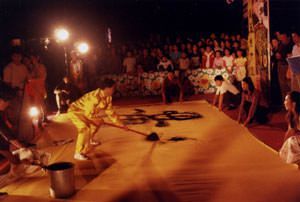The Name Sil in Japanese/Chinese on a Custom-Made Wall Scroll.
Click the "Customize" button next to your name below to start your personalized sil calligraphy artwork...
Switched to secondary search mode due to lack of results using primary.
These secondary results may not be very accurate. Try a different but similar meaning word or phrase for better results. Or...
Look up Sil in my Japanese Kanji & Chinese Character Dictionary(My dictionary is a different system then the calligraphy search you just tried)
If you want a special phrase, word, title, name, or proverb, feel free to contact me, and I will translate your custom calligraphy idea for you.
1. Ansil
2. Basil
3. Basile
4. Basilio
5. Brasilia
6. Dasilva
7. Drusilla
8. Inner Peace / Silence / Serenity
9. Jesila
10. Joysil
11. Masilo
12. Mokuso - Silent Meditation
14. Resilience / Restoration / Recovery
15. Resiliency
16. Resilient in the Face of Adversity
17. Rosilah
18. Sil
19. Silakshana
20. Silas
21. Silence
23. Silent Warrior
24. Silk
25. Silk Cloth
26. Silke
27. Silus
28. Silva
29. Silvana
30. Silvanus
31. Silver
32. Silvestre
33. Silvi
34. Silvia
35. Silvina
36. Silvio
37. Vasili
38. Wasili
39. Wassila
Ansil
Ansil
Basil
Basil
Basile
Basile
Basilio
Basilio
Brasilia
Brasilia
Dasilva
Dasilva
Drusilla
Drusilla
Inner Peace / Silence / Serenity
靜 is the simplest way to convey the meaning of inner peace and serenity.
靜 is often translated as “serenity.” It can also be used to express the ideas of still, calm, serene, quiet, silent, stillness, not moving, or tranquility.
In the old days, Chinese, Japanese, or Korean people might hang a wall scroll with this character in their reading room to bring about a sense of peace in the room.
![]() While they once used the same character form in Japan, they now use a slightly-simplified version in modern Japan (after WWII). This version is shown to the right, and can be selected for your wall scroll by clicking on that Kanji instead of the button above.
While they once used the same character form in Japan, they now use a slightly-simplified version in modern Japan (after WWII). This version is shown to the right, and can be selected for your wall scroll by clicking on that Kanji instead of the button above.
See Also: Peace
Jesila
Jesila
Joysil
Joysil
Masilo
Masilo
Mokuso - Silent Meditation
Resilience / Flexibility
彈性 means resilience, flexibility, or elasticity in Chinese characters and old Korean Hanja.
Resilience / Flexibility
Resilience / Restoration / Recovery
恢復力 suggests having the power to recover, restore, and rehabilitate. This can refer to yourself, someone else, or even to something, like rehabilitating a burned forest. 恢復力 is the essence of resilience in life.
The first two characters are a word that means to reinstate, resume, restore, recover, regain, or rehabilitate, restoration, rehabilitation, recovery, return, improvement, recovery (from an illness), recuperation, or convalescence.
The last character means strength or power.
See Also: Tenacity | Perseverance
Resiliency
Resiliency
Resilient in the Face of Adversity
打たれ強い is often used as a martial arts term.
It means being able to take a lot of punishment or being able to take a hit. In Japanese baseball, it can also refer to the pitcher's ability to keep his cool when the batter gets a hit. 打たれ強い is generally about being resilient and strong in the face of criticism or adversity.
Note: Because this selection contains some special Japanese Hiragana characters, it should be written by a Japanese calligrapher.
Rosilah
Rosilah
Silakshana
Silakshana
Silas
Silas
Silence
默 / 黙 means silent or silence and is often used in a Buddhist context.
Other meanings include dark, secret, or profound.
The original form is 默, but you will sometimes see it written in the 黙 Japanese variant form. If you want it in the Japanese form, please choose a Japanese calligrapher and use this to start your order instead of the button above: 黙
Silent / Solitary
寂 means silent, solitary, quiet, calm, still, rest, or tranquil.
This also has a strong association with Buddhism where it can mean “entering into Nirvana.” In that context, this is sometimes used to refer to the passing of a Buddhist monk (he is silent, as he has entered Nirvana). For the living, this is about tranquility (especially of mind).
Some will also use this to mean “elegant simplicity.”
From Sanskrit, this can represent praśama, vivikta, śānti, or nibbāna (nirvāṇa).
Silent Warrior
Silent Warrior
Silk
絲 is the simplest way to write silk in Chinese, Japanese Kanji, and old Korean Hanja.
This can also mean thread, and it is used as parts of words like “silk fabric” or “silk scarf.”
In Japanese, this can be the surname Ito.
絲 is used far more in Chinese for silk (silk comes from China) than in Japanese.
Silk Cloth
絹 is the Chinese, Japanese Kanji, and old Korean Hanja for thin, tough silk fabric, or silk cloth.
This can also be the Japanese female given name, Masami.
Silke
Silke
Silus
Silus
Silva
Silva
Silvana
Silvana
Silvanus
Silvanus
Silver
銀 is the Chinese, Japanese Kanji, and old Korean Hanja for silver.
This same word can refer to things that are silver-colored, money or currency, silver coins, or silver paint.
In Japanese, this can be a given name “Ginji.”
Silvestre
Silvestre
Silvi
Silvi
Silvia
Silvia
Silvina
Silvina
Silvio
Silvio
Vasili
Vasili
Wasili
Wasili
Wassila
Wassila
The following table may be helpful for those studying Chinese or Japanese...
| Title | Characters | Romaji (Romanized Japanese) | Various forms of Romanized Chinese | |
| Ansil | 安西爾 安西尔 | ān xī ěr an1 xi1 er3 an xi er anxier | an hsi erh anhsierh |
|
| Ansil | アンシル | anshiru | ||
| Basil | 巴西樂 巴西乐 | bā xī lè ba1 xi1 le4 ba xi le baxile | pa hsi le pahsile |
|
| Basil | バジル | bajiru | ||
| Basile | 巴西勒 | bā xī lè ba1 xi1 le4 ba xi le baxile | pa hsi le pahsile |
|
| Basile | バシル | bashiru | ||
| Basilio | 巴西略 | bā xī lu ba1 xi1 lue:4 ba xi lue: baxilue: | pa hsi pahsi |
|
| Basilio | バシリオ | bashirio | ||
| Brasilia | 巴西利亞 巴西利亚 | bā xī lì yà ba1 xi1 li4 ya4 ba xi li ya baxiliya | pa hsi li ya pahsiliya |
|
| Brasilia | ブラジリア | burajiria | ||
| Dasilva | 達席爾瓦 达席尔瓦 | dá xí ěr wǎ da2 xi2 er3 wa3 da xi er wa daxierwa | ta hsi erh wa tahsierhwa |
|
| Dasilva | ダシルバ | dashiruba | ||
| Drusilla | 德魯西拉 德鲁西拉 | dé lǔ xī lā de2 lu3 xi1 la1 de lu xi la deluxila | te lu hsi la teluhsila |
|
| Drusilla | ドルシラ | dorushira | ||
| Inner Peace Silence Serenity | 靜 静 | shizu / sei | jìng / jing4 / jing | ching |
| Jesila | 杰西拉 | jié xī lā jie2 xi1 la1 jie xi la jiexila | chieh hsi la chiehhsila |
|
| Jesila | ジェシラ | jeshira | ||
| Joysil | 喬伊希爾 乔伊希尔 | qiáo yī xī ěr qiao2 yi1 xi1 er3 qiao yi xi er qiaoyixier | ch`iao i hsi erh chiaoihsierh chiao i hsi erh |
|
| Joysil | ジョイシル | joishiru | ||
| Masilo | 馬西洛 马西洛 | mǎ xī luò ma3 xi1 luo4 ma xi luo maxiluo | ma hsi lo mahsilo |
|
| Masilo | マシロ | mashiro | ||
| Mokuso - Silent Meditation | 黙想 | mokusou / mokuso mokuso / mokuso | ||
| Resilience Flexibility | 彈性 弹性 | tán xìng / tan2 xing4 / tan xing / tanxing | t`an hsing / tanhsing / tan hsing | |
| Resilience Flexibility | 弾力性 | dan ryoku sei danryokusei | ||
| Resilience Restoration Recovery | 恢復力 恢复力 | huī fù lì hui1 fu4 li4 hui fu li huifuli | ||
| Resiliency | 強韌 强韧 | qiáng rèn qiang2 ren4 qiang ren qiangren | ch`iang jen chiangjen chiang jen |
|
| Resiliency | 反発力 | hanpatsuryoku | ||
| Resilient in the Face of Adversity | 打たれ強い | u ta re tsuyo i utaretsuyoi | ||
| Rosilah | 羅西拉 罗西拉 | luó xī lā luo2 xi1 la1 luo xi la luoxila | lo hsi la lohsila |
|
| Rosilah | ロシラ | roshira | ||
| Sil | 西爾 西尔 | xī ěr / xi1 er3 / xi er / xier | hsi erh / hsierh | |
| Sil | シル | shiru | ||
| Silakshana | 西拉克沙納 西拉克沙纳 | xī lā kè shā nà xi1 la1 ke4 sha1 na4 xi la ke sha na xilakeshana | hsi la k`o sha na hsilakoshana hsi la ko sha na |
|
| Silakshana | シラクシャナ | shirakushana | ||
| Silas | 塞拉斯 | sāi lā sī sai4 la1 si1 sai la si sailasi | sai la ssu sailassu |
|
| Silas | サイラス | sairasu | ||
| Silence | 默 / 黙 默 | moku | mò / mo4 / mo | |
| Silent Solitary | 寂 | jaku | jì / ji4 / ji | chi |
| Silent Warrior | 沉默的武士 | chén mò de wǔ shì chen2 mo4 de wu3 shi4 chen mo de wu shi chenmodewushi | ch`en mo te wu shih chenmotewushih chen mo te wu shih |
|
| Silent Warrior | 靜寂な戦士 静寂な戦士 | seijakuna senshi seijakunasenshi | ||
| Silk | 絲 丝 | shi / ito | sī / si1 / si | ssu |
| Silk Cloth | 絹 绢 | kinu | juàn / juan4 / juan | chüan |
| Silke | 西爾克 西尔克 | xī ěr kè xi1 er3 ke4 xi er ke xierke | hsi erh k`o hsierhko hsi erh ko |
|
| Silke | シオイク | shioiku | ||
| Silus | 西盧斯 西卢斯 | xī lú sī xi1 lu2 si1 xi lu si xilusi | hsi lu ssu hsilussu |
|
| Silus | シラス | shirasu | ||
| Silva | 席爾瓦 席尔瓦 | xí ěr wǎ xi2 er3 wa3 xi er wa xierwa | hsi erh wa hsierhwa |
|
| Silva | シルバ | shiruba | ||
| Silvana | 茜爾瓦娜 茜尔瓦娜 | xī ěr wǎ nà xi1 er3 wa3 na4 xi er wa na xierwana | hsi erh wa na hsierhwana |
|
| Silvana | シルバナ | shirubana | ||
| Silvanus | 西爾瓦努斯 西尔瓦努斯 | xī ěr wǎ nǔ sī xi1 er3 wa3 nu3 si1 xi er wa nu si xierwanusi | hsi erh wa nu ssu hsierhwanussu |
|
| Silvanus | シルバニャス | shirubanyasu | ||
| Silver | 銀 银 | shirogane / shirogane | yín / yin2 / yin | |
| Silvestre | 西爾維斯特 西尔维斯特 | xī ěr wéi sī tè xi1 er3 wei2 si1 te4 xi er wei si te xierweisite | hsi erh wei ssu t`e hsierhweissute hsi erh wei ssu te |
|
| Silvestre | シルヴェストル | shiruvesutoru | ||
| Silvi | 席爾維 席尔维 | xí ěr wéi xi2 er3 wei2 xi er wei xierwei | hsi erh wei hsierhwei |
|
| Silvi | シルヴィ | shiruvi | ||
| Silvia | 西爾維亞 西尔维亚 | xī ěr wéi yà xi1 er3 wei2 ya4 xi er wei ya xierweiya | hsi erh wei ya hsierhweiya |
|
| Silvia | シルヴィア | shiruvia | ||
| Silvina | 西爾維納 西尔维纳 | xī ěr wéi nà xi1 er3 wei2 na4 xi er wei na xierweina | hsi erh wei na hsierhweina |
|
| Silvina | シルビナ | shirubina | ||
| Silvio | 西爾維奧 西尔维奥 | xī ěr wéi ào xi1 er3 wei2 ao4 xi er wei ao xierweiao | hsi erh wei ao hsierhweiao |
|
| Silvio | シルビオ | shirubio | ||
| Vasili | 瓦西里 | wǎ xī lǐ wa3 xi1 li3 wa xi li waxili | wa hsi li wahsili |
|
| Vasili | ヴァシリ | vashiri | ||
| Wasili | 瓦西里 | wǎ xī lǐ wa3 xi1 li3 wa xi li waxili | wa hsi li wahsili |
|
| Wasili | ワシリ | washiri | ||
| Wassila | 瓦希拉 | wǎ xī lā wa3 xi1 la1 wa xi la waxila | wa hsi la wahsila |
|
| Wassila | ワシラ | washira | ||
| In some entries above you will see that characters have different versions above and below a line. In these cases, the characters above the line are Traditional Chinese, while the ones below are Simplified Chinese. | ||||


